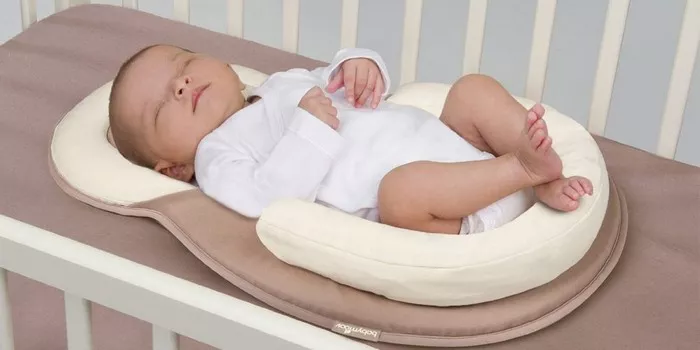Infant sleep positioners have become a subject of both curiosity and concern among parents seeking the best for their newborns. In the pursuit of ensuring optimal safety and comfort for infants during sleep, caregivers often turn to various aids, including sleep positioners. However, the safety of these devices has been questioned, leading to debates among healthcare professionals and parents alike. In this comprehensive article, we delve into the safety aspects of infant sleep positioners, debunking myths and providing insights into the risks associated with their use.
Understanding Infant Sleep Positioners
Infant sleep positioners are cushioned devices designed to keep a baby in a specific position while sleeping. They typically consist of a cushioned mat with bolsters or wedges on either side to prevent the infant from rolling onto their side or stomach during sleep. The intended purpose of these devices is to promote back sleeping, which is recommended by pediatricians to reduce the risk of sudden infant death syndrome (SIDS) and suffocation.
The Controversy Surrounding Infant Sleep Positioners
Despite their intended purpose, infant sleep positioners have stirred controversy due to safety concerns. One of the primary issues is the potential risk of suffocation if the baby’s face becomes pressed against the cushioning or wedges. Additionally, there have been cases where infants have slipped down or become trapped between the positioner and the side of the crib, raising further alarm among caregivers.
The American Academy of Pediatrics (AAP) strongly advises against the use of infant sleep positioners, citing the lack of evidence to support their effectiveness in preventing SIDS and the potential hazards they pose. Furthermore, the U.S. Food and Drug Administration (FDA) has issued warnings against the use of certain types of sleep positioners, emphasizing the need for caution when considering such products.
Debunking Myths About Infant Sleep Positioners
Despite the warnings and concerns surrounding infant sleep positioners, some myths persist regarding their safety and effectiveness. Let’s examine and debunk some of these misconceptions:
Myth 1: Sleep positioners prevent SIDS.
Fact: While back sleeping is recommended to reduce the risk of SIDS, sleep positioners have not been proven to prevent SIDS. In fact, the AAP emphasizes that the safest sleep environment for infants is a firm mattress with no loose bedding or soft objects.
Myth 2: Sleep positioners are approved by healthcare professionals.
Fact: Many healthcare professionals, including pediatricians and organizations like the AAP, advise against the use of infant sleep positioners due to safety concerns. Approval and recommendation from healthcare professionals are not indicative of a product’s safety.
Myth 3: Sleep positioners are necessary for keeping infants in a safe sleeping position.
Fact: Infants are capable of moving and changing positions during sleep, and attempting to restrict their movements with sleep positioners may increase the risk of suffocation or entrapment. Creating a safe sleep environment with a firm mattress and removing hazards from the crib is more effective than using sleep positioners.
Understanding the Risks Associated with Infant Sleep Positioners
While the intention behind using infant sleep positioners may be to enhance safety during sleep, it’s essential to recognize the potential risks associated with these devices:
1. Risk of Suffocation: The cushioning and wedges of sleep positioners can pose a suffocation risk if the infant’s face becomes pressed against them, obstructing the airway.
2. Risk of Entrapment: Infants may slide down or become trapped between the positioner and the side of the crib, increasing the risk of injury or suffocation.
3. Risk of Overheating: The use of sleep positioners, particularly those with excessive padding, may contribute to overheating, which is a risk factor for SIDS.
4. Lack of Evidence: Despite claims of effectiveness, there is limited scientific evidence to support the use of infant sleep positioners in preventing SIDS or promoting safe sleep practices.
Alternatives to Infant Sleep Positioners
Given the safety concerns surrounding infant sleep positioners, parents may wonder what alternatives are available to promote safe sleep for their infants. Here are some recommendations endorsed by pediatric experts:
1. Back Sleeping: Placing infants on their back to sleep is the safest sleep position and is recommended by the AAP to reduce the risk of SIDS.
2. Firm Mattress: Use a firm mattress with a fitted sheet in the crib to provide a safe sleeping surface for infants.
3. Room Sharing: Share a room with your baby, but not the same sleeping surface, for the first six to twelve months to facilitate monitoring and breastfeeding while reducing the risk of SIDS.
4. Avoidance of Soft Bedding: Remove soft bedding, including pillows, blankets, and stuffed animals, from the crib to reduce the risk of suffocation and SIDS.
5. Regular Check-Ins: Check on your baby regularly during sleep to ensure they are in a safe sleeping position and environment.
Conclusion
Infant sleep positioners have generated considerable debate due to concerns regarding their safety and effectiveness. While the intention behind using these devices is to promote safe sleep practices and reduce the risk of SIDS, the evidence supporting their use is lacking, and they pose potential risks of suffocation, entrapment, and overheating.
Parents are encouraged to prioritize safe sleep practices recommended by pediatric experts, including back sleeping on a firm mattress, room sharing without bed sharing, and removing hazards from the crib. By following these guidelines, caregivers can create a safe sleep environment for their infants without relying on potentially risky sleep positioners.
In conclusion, the safety of infant sleep positioners remains a contentious issue, and caregivers should exercise caution and prioritize evidence-based practices to ensure the well-being of their babies during sleep.


